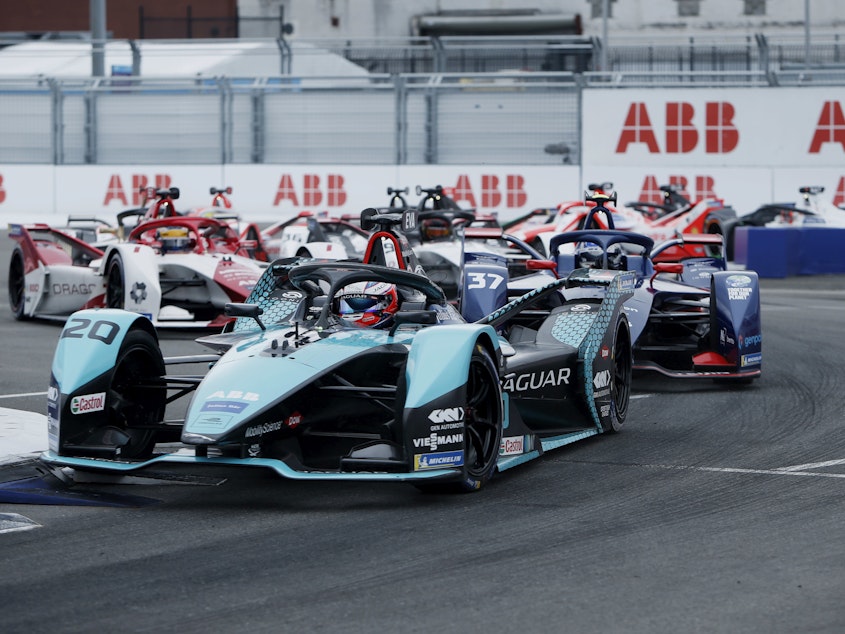With A Whirr, Not A Roar, Auto Racing Drives Toward An Electric Future

Earlier this month, two dozen low-slung, open-cockpit race cars sped around the streets of Red Hook in Brooklyn.
A distinct high-pitched whizzing sound pierced the air, instead of the usual growl of revved-up race car engines. That's because these cars were powered entirely by batteries rather than gasoline.
Welcome to Formula E. It's like Formula 1, but it's all-electric.
"Combustion engines are over," Alberto Longo, the co-founder of Formula E, said in early July. "End of story."
Formula E has declared itself the future of racing. At a time when virtually the entire auto industry is embracing the electric vehicle, it's not considered quite as wild of an assertion, though it was seen as a bit of an oddity when the motorsport first launched in 2014.
As electric vehicles race toward the mainstream, the technology has been improving rapidly.
And Formula E is helping to accelerate that progress, the race organizers argue, by serving as an incubator for improved technology – from more efficient motors to faster chargers – that will eventually wind up in ordinary vehicles.
"Every four years we need to change, because technology is advancing so quickly," Longo says. "Every four years your technology is obsolete."
Charging cars in seconds? It's in the works
When Formula E first launched, the batteries in the cars couldn't last for an entire 45-minute race — so drivers stopped halfway through and swapped cars for a new vehicle with a full charge.
Now the event is on its second generation of vehicles. This time, the battery can last an entire race ... usually. It's possible for drivers to run out of juice if they and their pit crews miscalculate. This spring, there was one race where half the drivers didn't cross the finish line.
The third generation of vehicles is in the works. They will be lighter and faster (today, Formula E cars are still significantly slower than their Formula 1 cousins). And to make their smaller batteries last for an entire race, the drivers will stop and charge mid-race — plugging in, as a pit stop.
Stephanie Medeiros is the head of e-mobility for ABB, a Swiss-Swedish company that makes electric vehicle chargers and is the title sponsor for Formula E. ABB will be providing the charging technology to make this pit-stop charging possible.
The new vehicles won't be racing until 2022, so Medeiros says she can't provide exact numbers on how quick the pit stops will be.
"The idea is to really shorten it as much as possible," she says. "Whether it's 30 seconds or 60 seconds ... it'll be fast, that's for sure."
How racetracks encourage innovation
Medeiros says that solving the challenge of pit stop charging will provide ABB with valuable data and lessons learned that will, in turn, help charging improve for consumer vehicles. (This is a major issue for would-be electric car buyers, many of whom are not interested in vehicles that take 30 minutes to an hour to fast-charge on a road trip.)
Ten different vehicle manufacturers participate in Formula E right now. All the teams in the race use the same body and battery, but can design their own motor and software to try to gain an advantage over each other on the track.
That means energy management — making engines as efficient as possible, and determining how the battery's power is deployed in given situations — is key.
"Formula E is an amazing place where we invest a lot in the efficiency of the hardware ... and the energy management software," says Tommaso Volpe, the head of motorsports for Nissan.
He points to regenerative braking – technology that allows a car to recharge while it slows down – as an example of an area where Formula E is pushing Nissan to develop more sophisticated technology, which will enable improvements for more mainstream Nissan vehicles in the future.
This argument is not unique to Formula E; advocates of motorsports in general often say that races serve as technology incubators.
But Sam Abuelsamid, an analyst at the consulting firm Guidehouse Insights who specializes in electric vehicles, says Formula E has a particularly strong case to make, pointing to thermal management and induction motors as areas where the race really has pushed technology forward.
"Since [electric vehicles] are still relatively new, there are more opportunities to learn here than with traditional internal combustion race cars," he says.
Squeals or spaceships: Car sounds that split opinions
Formula E is part sport and part engineering showcase. But it's also a major marketing event.
That's a big reason why the races are held in the middle of major cities, so passers-by can catch a glimpse of the spectacle.
Like three twenty-something Brooklyn-dwellers who found themselves near the racetrack in Brooklyn's Red Hook by mistake.
They had been in Brooklyn intending to see a free art exhibition. Instead, Grace Hopkins, Soham Khadatare and Sibylle Hornung found themselves catching a peek at the race, and listening to the high-pitched whizzing sounds as the cars raced around the streets.
"This sounds more like squealing, like an animal in pain," Khadatare says, noting he's not sold on it.
"For me, it reminds me of space!" said Hornung. "It's exciting," Hopkins agreed.
Whether bystanders found the sound painful or alluringly spaceship-like, Formula E is just glad that the race is catching people's attention. [Copyright 2021 NPR]



